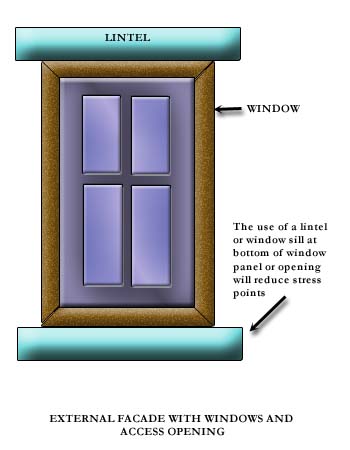Case 2
- Introduction
- Causes of Defects
- Good Practices
- Standards
- Maintenance and Diagnostics
- Remedial
- Similar Cases
- References
Good Practices
Window detailing
When designing openings in brick walls and concrete walls, care should be taken to incorporate design features to reinforce the opening so that stress could be be relieved from the corners and cracks could be prevented. A lintel or sill could take the stress at the top and bottom of the opening respectively. See Figure below.
Alternative 1

Alternative 2

Design
Tall slender concrete structures should be designed with due consideration of the effects of lateral deflection and be within acceptable vibration limits in accordance with BS EN 1992-1-1, SS EN 1992-
1-2, CP 65-1 or equivalent. Any deflection/deformation of the concrete structure due to vertical loading should be compatible with the degree of movement acceptable by other elements (i.e., the finishes, services, partition, glazing and cladding) in accordance with BS EN 1992-1-1 or equivalent. Limit State Method should be considered for design and verification of structure for durability of façade structures. Refer to modelling of deterioration process in accordance with ISO 13823 or equivalent.
The causes, effects and methods of prevention and repair for cracks (e.g., longitudinal cracks, transverse cracks, cracks above prestressing strands, web crack at or near the prestressing strands, corner
crack, and miscellaneous cracks) in precast concrete wall panels should be considered and applied in
accordance with BS EN 13369, SS 677 or equivalent. Limit the design crack width with reference to CP
65-2 or equivalent. Laboratory mechanical tests should be carried out to measure deformations on horizontal joints between load-bearing walls and concrete floors in accordance with ISO 7845 or equivalent.
Construction
Use two-stage joints for precast façade construction to ensure higher watertightness performance, since doing so will avoid seepage through hairline cracks, as is the case with one-stage joints in accordance
with SS EN 1992-1-2 or equivalent. Seal off horizontal joints for load bearing walls with non-shrink grout. Minimise cracks in rendered brick walls by using appropriate mix ratio, thickness and number of coats. Provide bonding bars at interfaces between different materials in order to minimise cracks (e.g., where a brick wall abuts concrete). Alternatively, the bonding bars can be cast together with the concrete member.
At the completion of the construction stage, minor repair work or fixing adjustments may be acceptable. Enhance the durability of vulnerable parts of construction; ensure that surfaces exposed to water are freely drained; provide adequate cover to steel; use protective coatings for either steel or the concrete, or
both in accordance with BS EN 1992-1-1, SS EN 1992-1-1, SS EN 1992-1-2, CP 65-1 or equivalent. Make accessible components of which predicted service life is less than the design life of the structure for inspection, and replace them in accordance with ISO 13823 or equivalent.